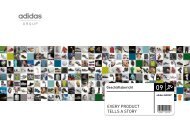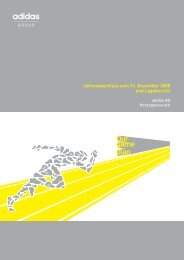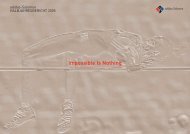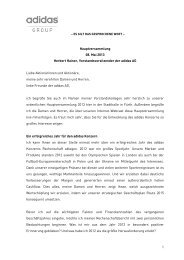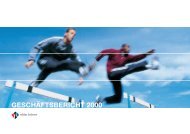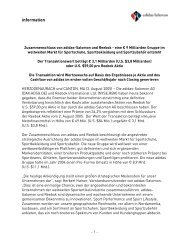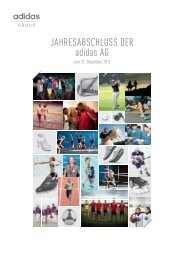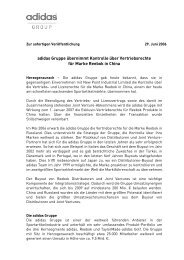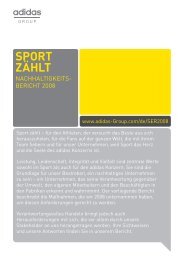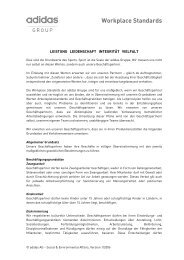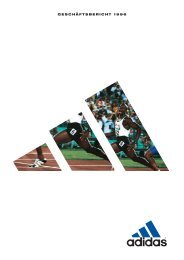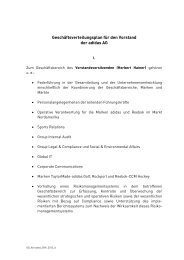Environment PDF - adidas Group
Environment PDF - adidas Group
Environment PDF - adidas Group
Create successful ePaper yourself
Turn your PDF publications into a flip-book with our unique Google optimized e-Paper software.
TACKLINg CHALLeNgeS<br />
“Cost is the biggest challenge. In many cases more<br />
sustainable alternatives are more expensive,” says Heini.<br />
“That can be because of a limited supply or simply because it<br />
is new and you don’t have a large product base to use it on,”<br />
explains Joan.<br />
This is certainly the case with e.g. organic cotton. However,<br />
the <strong>adidas</strong> group was a founding member of the Better<br />
Cotton Initiative (BCI), which aims to help farmers produce<br />
sustainable cotton more effectively and offer them in<br />
mainstream market. The first harvest of ‘Better Cotton’ was<br />
only in October 2010, so there is only limited supply yet. And<br />
the <strong>adidas</strong> group has committed to using 100% Sustainable<br />
Cotton by 2018, see page 28. “It is a volatile market so we<br />
think we are helping to ensure our own security of supply<br />
by developing relationships with the spinners and cotton<br />
farmers and further strengthen the partnership with our<br />
direct fabric suppliers,” says philipp meister from the<br />
Apparel materials development team. “Our commitment to<br />
sustainability is effectively driving us deeper into our supply<br />
chain.”<br />
SUCCeSSeS THIS YeAR<br />
To address some of the challenges around cost and supply,<br />
the Apparel development team works together with the<br />
suppliers in order to set a seasonal guideline for the<br />
sustainable material premium those suppliers can charge<br />
for organic cotton or recycled polyester. This allows the<br />
product teams to calculate their margins with more certainty<br />
earlier in the process which encourages them to choose the<br />
more sustainable option.<br />
The footwear team has made great strides in recycling<br />
factory waste. Working with companies that make injected<br />
plastic plates for football boots, they are now recycling 99%<br />
of that waste back into production. And they have also been<br />
able to increase the percentage of rubber and eVA that can<br />
be reground and reused in shoes.<br />
THe fUTURe<br />
It has been more than ten years since the <strong>adidas</strong> group first<br />
produced a restricted substances list and nearly as long<br />
since it stopped using pVC in mainstream applications.<br />
Now the material guidelines are updated twice a year for<br />
each new season. So things have come a long way in that<br />
time. Joan is convinced that even closer working with other<br />
brands and suppliers is key to more success in the future.<br />
“protecting the environment is not a point of competition<br />
between brands. It is a substantial, base-line principle:<br />
consumers just expect it now. So ideally the brands should<br />
collaborate more. The cleaner and more consistent our<br />
message as brands is to suppliers, the easier it will be for<br />
them to take waste out of their systems.”<br />
MATERIALS OVERVIEW<br />
01 ABOUT OUR pROgRAmme<br />
17 eNVIRONmeNT<br />
41 SUppLIeRS<br />
57 empLOYeeS<br />
64 COmmUNITY<br />
72 peRfORmANCe<br />
102 gRI INdex<br />
The design for environment approach applied to materials<br />
is about innovating to reduce the overall environmental<br />
impact of materials used to develop our products. The<br />
approach considers the environmental impact of the material<br />
throughout its life cycle and encourages us to use recycled<br />
or sustainable materials.<br />
mORe SUSTAINABLe mATeRIALS<br />
more sustainable materials are materials that have a lower<br />
overall environmental impact during their life cycle than<br />
conventional ones. We are improving our own guidelines on<br />
Sustainable materials, and pro-actively drive sustainable<br />
material innovation in partnership with our key suppliers and<br />
industry leaders.<br />
Read more about how we assess materials on page 28.<br />
The most commonly used materials are recycled polyester,<br />
organic cotton, ‘Better Cotton’ as a future development,<br />
polylactic Acid (pLA), Tencel (a fibre made from wood pulp),<br />
non-mulesed wool for apparel and leather. Some of these<br />
are described briefly below.<br />
ReCYCLed mATeRIALS<br />
We source various recycled materials such as inlay soles,<br />
textiles, metals, plastics, packaging, and rubber. Using<br />
recycled materials prevents waste, reduces the consumption<br />
of fresh raw materials, and lowers the total amount of<br />
energy required to make products.<br />
WORKINg CONdITIONS IN THe COTTON INdUSTRY<br />
The <strong>adidas</strong> group and our consumers worldwide are aware<br />
of and concerned by the social and environmental conditions<br />
that exist today in certain parts of the cotton industry.<br />
These conditions, in the worst cases, include child labour<br />
and human exposure to pesticides and environmental<br />
pollution. There have been reported cases of the widespread<br />
use of forced child labour practices in cotton cultivation<br />
in Uzbekistan. We have joined others in condemning this<br />
practice and have called on our suppliers to ensure they do<br />
not source cotton from Uzbekistan.<br />
Read more about this in the About our programme section<br />
on page 1.<br />
Through our commitment to the Better Cotton Initiative,<br />
which includes labour conditions in its assessment criteria,<br />
we have taken a clear position on our requirements for safe<br />
and healthy working conditions in the cotton industry.<br />
Read more about our ‘Better Cotton’ commitment on<br />
page 28.<br />
IN THE REAL WORLD PERFORMANCE COUNTS Sustainability Report 2010<br />
26



